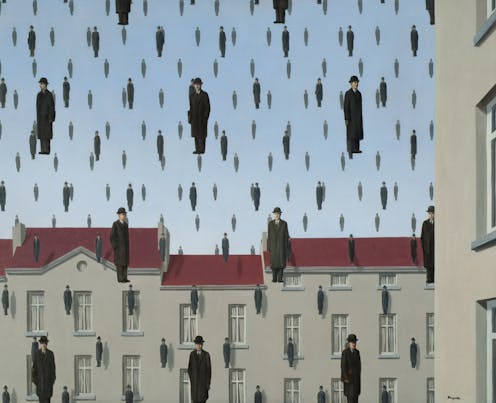how René Magritte led the Belgian surrealist movement
- Written by Victoria Souliman, Lecturer, French and Francophone Studies, University of Sydney

René Magritte is renowned for his humorous yet enigmatic art, foremost of which is the iconic bowler-hatted man. But despite his significant contribution to Surrealism – and the fame of his works – the evolution of his artistic practice isn’t widely known.
The Art Gallery of New South Wales’ Magritte exhibit marks the first major exhibition of the artist’s work in Australia, opening almost exactly 100 years after André Breton published the first Surrealist Manifesto in 1924.
The exhibition unveils four decades of Magritte’s unique artistic vision, with more than 100 works from collections across Australia, Belgium, Japan and the United States.
The man beyond the bowler hat
Magritte was born in 1898 in Lessines, Belgium. He developed a strong passion for painting early on. At just 16, he enrolled in the Académie des Beaux-Arts in Brussels, where he received traditional artistic training. He also worked as a graphic designer in his early career to support himself financially, creating various advertisements for magazine covers and posters.
Magritte was driven to explore and enhance his artistic practice beyond the Belgian art scene’s conservative aesthetics and limited opportunities for experimentation.
He found inspiration in magazines, journals and exhibition catalogues depicting avant-garde works. His earliest known self-portrait exemplifies his early influence by Cubism. It is a double-sided work, with one side featuring a painted portrait of Georgette Berger (who later became Magritte’s wife) playing the piano.
However, it was Magritte’s encounter with surrealist artworks (particularly Italian artist Giorgio De Chirico’s Le Chant d’amour, with its dreamlike atmosphere) which greatly impacted his practice.
From the mid-1920s, Magritte began to develop personal and poetic images featuring familiar objects rendered realistically yet set in unexpected combinations. He also introduced motifs that would appear throughout his career, such as curtains, toys, clouds and boulders. His first solo exhibition at the Galerie Le Centaure in Brussels signalled his allegiance to Surrealism.
Art as a process of reasoning
The Magritte exhibition foregrounds the artist’s work in the context of Belgian Surrealism, emphasising how he was influenced by fellow writers, philosophers and artists in Brussels.
Among these figures was the poet Paul Nougé, the founding figure of Belgian Surrealism in 1926. Nougé introduced a more scientific and rationalist perspective to the Belgian movement, differentiating it from its Parisian counterpart.
Parisian Surrealism was fascinated by psychoanalysis, focusing on the irrational and the unconscious. Belgian Surrealism, meanwhile, directed its attention towards consciousness, rationality and the search for meaning. This methodology clashed with the convictions of Parisian surrealists.
Although Magritte worked with the Parisian surrealists from 1927 to 1930 while living in Paris, he maintained a degree of independence. He considered his artistic practice as a process of reasoning.
While in Paris, Magritte developed his word-pictures, as seen in The Literal Meaning and the famous The Treachery of Images (more familiarly known as Ceci n'est pas une pipe, or This is not a pipe), which today is regarded as a landmark in the history of European modern art.
His approach relied on Nougé’s reflection on the nature and status of words and images, pointing to the arbitrary nature of language. In these works, Magritte invites us to take part in a linguistic game, making us question the relationship between an object, its name and its representative image.
Back in Brussels, Magritte explored what he considered philosophical “problems” through rigorously, almost mathematically, constructed paintings. He sought to reconcile the object represented and “the thing attached to it in the shadow of consciousness” through the mediation of the canvas.
In The Human Condition, he addresses the “problem of the window” as an object to look through and as a metaphor for traditional perspectival painting, revealing the way we perceive external realities through our own internal conceptualisation.
‘Sunlit Surrealism’ and lesser-known works
The Magritte exhibit also highlights some surprising and much lesser-known works. By the mid-1930s, the artist had gained significant recognition in Europe and beyond. However, the onset of World War II prompted him to question the relevance of Surrealism as a response to the war.
He sought new approaches to Surrealism. With “Sunlit Surrealism” he looked at images evocative of happiness, adopting an impressionist style characterised by feathery brushstrokes reminiscent of Auguste Renoir, as depicted in A stroke of luck.
In the 1950s and ‘60s, Magritte returned to the realistic style that defines his work. In his art series The Dominion of Light, he creates a paradoxical image. We view the qualities of light from opposite times of day, highlighting the ambiguity created by the coexistence of light and dark.
A continuing legacy
Magritte also influenced the next generation of artists associated with pop art and conceptual art, including those well beyond his time.
Today, his influence is evident in popular visual culture, from Pedro Almodóvar’s 2009 film Broken Embraces, to Beyoncé’s music video for Mine, which references The lovers.
Magritte’s work continues to be relevant, with its exploration of perception and the porous relationship between images and reality. This theme is highly pertinent in the age of AI, where the line between the artificial and real seems increasingly blurred.
More than 50 years after his death, Magritte continues to encourage us to reflect on how we perceive, experience and describe the world around us.
Authors: Victoria Souliman, Lecturer, French and Francophone Studies, University of Sydney





